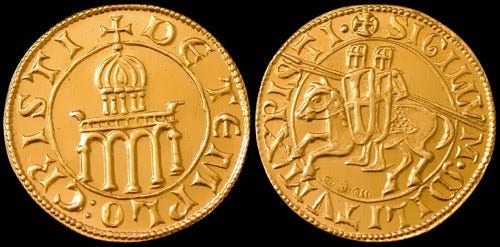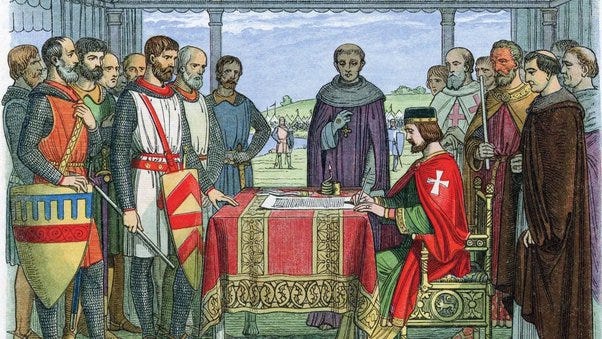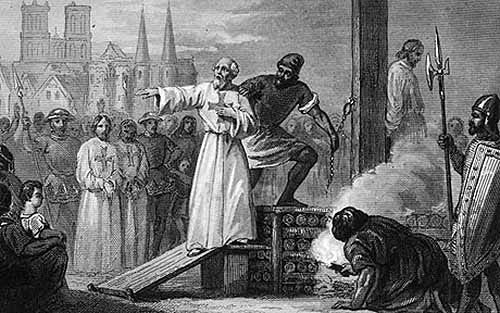Popularly known as Knights Templars, they began their existence as “The Poor Fellow-Soldiers of Christ and the Temple of Solomon”, were in reality not so poor by any measure. As a Catholic military order founded in the year 1119 CE, in the immediate aftermath of the First Crusade, they had all the trappings of a bank and are considered to be the first corporate bank, who played a key role in the development of modern banking. They created a rule based, well-oiled system that allowed pilgrims travelling to the Holy Land, to deposit money at a local Templar preceptory and receive a coded document to withdraw their funds at their destination. This system was a precursor to modern banking, providing deposits and security, which further allowed the Templars to lend money and develop other financial products.
Apart from secure transfer of pilgrim money, the banking operations of the Knights Templar included loans to monarchs and nobles. Using their networks and presence across Europe, the Templars provided large sums of money for crusading and other ventures of the ruling and knightly class, which helped to establish them as a powerful financial force across Europe and the Middle East. Their innovative use of issuing letters of credit was the earliest form of banking cheques. Beyond banking, they also had a big role in managing vast economic resources and lands across Europe and the Middle East. They developed sophisticated methods for fund management and their ability to conduct complex financial transactions gave them an ability to influence the economic landscape of the regions in which they operated.
As William Goetzmann quotes in his book, “Money Changes Everything”
“The Knights Templar might appear to be an unusual subject for a study of financial history. They were a religious order that developed during the Crusades. However, they are an important case of a social institution that repurposed itself as a financial institution. By the fourteenth century, the Templars had become a vast extra- governmental entity that controlled large parts of the European economy and the finances of some of its major kingdoms. They became essential financial intermediaries, despite being sworn to a vow of poverty and to an entirely religious mission. The story of how the Templars became repurposed to serve Europe’s financial as opposed to its spiritual needs is instructive.”
Origins
In 1099, Jerusalem was captured by an army of the First Crusade. In the aftermath there was a huge demand from pilgrims in Europe to travel to the Holy Land and visit the sacred shrines of Christendom. Though the city of Jerusalem was under relatively secure control of the Christian army, the route to reach the destination was not. Pilgrims came in droves and had to carry gold and silver coins with them, as it was the only form of liquid capital available. Banditry was rampant and the roads leading to Jerusalem were notorious, where pilgrims were regularly attacked and killed as they lacked the means and capabilities to protect themselves and their possessions.
In 1119, a French knight and a veteran of the First Crusade, Hugues de Payen proposed the creation of a monastic order for the protection of these pilgrims. King Baldwin II of Jerusalem agreed to their sacred cause and provided them with space on the Temple Mount, in the captured Al Aqsa Mosque compound. The Temple Mount was bathed in mystique as it sat above what were believed to be the ruins of the Temple of Solomon, and it was from this location that the Order took the name of Poor Knights of Christ and the Temple of Solomon, or "Templar" knights. Hugues de Payen led the original order of nine knights and all of them took vows of poverty, chastity, and obedience. In the beginning, the Order had few financial resources and relied on donations to survive. Their seal was double sided, with one side showing two knights riding on a single horse, emphasizing the order's poverty, and the other side a picture of Dome of Rock on the temple mount.
The Templars' impoverished status did not last long. They had a powerful advocate in Saint Bernard of Clairvaux, a leading Church figure who fervently supported their cause. In 1129 at the Council of Troyes, the order was officially endorsed by the Church. Kings, Dukes and Counts showed their appreciation for the cause and demonstrated their generosity by bestowing donations and grants. The Templars were well placed to take advantage of the charity that was flowing for the cause, making them a prime target for such gift giving. The Templars became a favored charity throughout Christendom, receiving money, precious metals, land and businesses from families who were eager to help with the fight in the Holy Land. Some of the notable early donors to the Templars cause were the who is who of European Christendom. Henry I and Stepehen, kings of England made substantial contributions and so did Elenor of Aquitaine. One of the most notable contributions came from Alfonso I of Aragon, who left one third of his kingdom to their cause. Lesser nobles also contributed with great enthusiasm and the order soon established preceptories across Europe. Other donations came in the form of feudal rights and taxes assigned from kings and dukes to the Templars. They even received a cut of lands they helped conquer. The kings of Aragon promised the Templars a fifth of all booty and property seized in the wars against the Moors.
Their financial capabilities were further boosted when in 1139, Pope Innocent II's papal bull “Omne Datum Optimum” exempted the Order from obedience to local laws. This ruling meant that the Templars could pass freely through all borders, were not required to pay any taxes, and were exempt from all authority except that of the Pope. King Stephen of England exempted the order from all taxes, and this was later strengthened by a charter granted by Richard the Lion Heart in 1189. Generous grants of land, precious metals, tax exemptions and ecclesiastical privileges were the foundation of a vast economic network that would back the Templars in the holy land.
Banking and Fortune
The Knights Templar recognizing the need for secure wealth transfer, responded by developing some innovative systems that can be seen a precursor to modern banking. They established a network that stretched from the coasts of Atlantic to the River Jordan, which facilitated the secure movement of people and money. Through the creation of the letter of credit, they allowed depositors to store their wealth at one Templar house and withdraw it at another by presenting the letter. The travellers did not have the need to carry large sums of precious metals, reducing the risk of theft. This mechanism not only ensured the safety of assets but also enabled the Templars to accumulate and redistribute wealth across their network.
The Templars established a sophisticated financial network with main banking centres and satellite branches spread across Europe. This hub and spoke network helped then develop and facilitate a range of financial services that catered to merchants, pilgrims, and the nobility. The main banking center, such as the one in Paris was a crucial node in this network. These centres conducted large transactions, maintained extensive records, and amassed significant wealth. Paris, notable for its particularly vast holdings, exemplified the wealth and power of the Templars, with extensive properties and lands under their control.
Some of the important centres of Templar banking were:
1. Jerusalem: As their initial headquarters, Jerusalem was a central banking hub. After the First Crusade, the Templars took up residence on the Temple Mount, which became a key site for their religious and banking activities.
2. Acre: Following the fall of Jerusalem in 1187, the Templars moved their headquarters to Acre. This city then became the new administrative center and a major banking hub until the Templars were driven out of the Holy Land.
3. Paris: The Paris Temple, famously associated with the trial and dissolution of the Templars, served as their European financial headquarters. It was effectively the center of their European banking operations, holding vast amounts of wealth and serving numerous clients, including French royalty.
4. London: The New Temple in London was another significant site. It managed substantial financial activities and served as a treasury for the English crown and nobility.
5. Poitiers: In France, Poitiers was an important administrative and financial center for the Templars, often used for regional management of their affairs.
6. Genoa: Although not a primary headquarters for the Templars, Genoa was an important link in their banking network. The city's strategic location on the Mediterranean Sea made it a vital port for trade and finance. The Templars used such ports to facilitate the transfer of money and goods between the East and the West.
7. Venice: Like Genoa, Venice was crucial for its maritime strength and extensive trade networks. The Templars leveraged Venice's capabilities to manage financial transactions throughout the Mediterranean. Venice's role in the Crusades, often as a departure point for the Holy Land, also increased its interactions with Templar financial activities.
8. Bruges: In the north, Bruges was a center of commerce during the medieval period. While not a Templar stronghold, its importance as a trading hub in Europe meant that Templar banking activities likely intersected with local and international merchants there, facilitating the exchange and safekeeping of assets.
Templar banking also extended to providing loans to monarchs and nobles, often for funding military campaigns or managing ransoms. The ability to mobilize large sums of money quickly made the Templars indispensable financial partners to the European elite. Over a period of time, the Templars developed a close association with several monarchs. They served as financial managers and treasurers to the Kings of France, England, Scotland, Ireland, and many other kingdoms. In fact, the French treasury was housed in a Templar house in Paris for some time.
Due to their close association with kings, the Templars were entrusted with the responsibility of collecting taxes from the public. When the Saladin Tax was levied in England after the capture of Jerusalem by Saladin, it was the Templars who collected the tax from every household in England. Apart from collecting money from the public, the Templars also had to play the role of Almoners – people in charge of distributing royal largesse to the public. Due to their prodigious knowledge, the Templars were also asked to serve as accountants by many kings. Whenever a king or bishop had reason to doubt someone’s accounts, they would ask a Templar to audit the accounts.
Apart from safekeeping, accounting, and collection and distribution of funds, the Templars also provided a wide range of other financial services. They brokered financial deals and facilitated the buying and selling of various assets. One of the most notable deals was King Henry III’s purchase of the island of Oleron, brokered by the Templars. Due to their reputation as incorruptible warriors, the Templars were often trusted with prized possessions and rare commodities that no one else could be trusted with. Such was the level of trust they enjoyed that at one point in the 12th century, the Crown Jewels of England were kept in a Templar house as collateral for a loan.
The complexity of Templar financial arrangements, from their transfer system to their records of account to their depository function and finally to their contractual arrangements for ownership of property and the assignment of the yields on these properties, is an important prelude to the development of the first European capital markets. The Templars organization was a technological response to the needs of a European society, which had to move assets great distances, across seas and through dangerous terrain in the midst of wars and uncertainty. The Templars responded to the needs of a constellation of European rulers who lacked financial power, who relied chronically on loans to meet military and political needs, and yet at the same time required neutral, nonpolitical entities with whom to
entrust their finances. The Templars served the pope and the monarchs of England, France, and the Iberian kingdoms with equal fidelity, even in times when these rulers warred against one another.
The Templars, with their unique position backed by the Church and European monarchies, could operate across national borders with unprecedented scale and security. Their system facilitated international trade and finance in a way that other contemporary systems could not match, setting a benchmark for multinational banking that would evolve into future global financial systems. While the Lombards and Jews also operated financial systems of significance, they paled in comparison to the Templars. The Lombards primarily provided loans and charged interest, which the Templars typically avoided due to Church prohibitions against usury. Jewish bankers were similarly engaged in lending activities but were often limited by legal restrictions and widespread prejudice, which affected their ability to operate on the scale of the Templars. The fall of the Templar Order in the early 14th century led to the absorption of their banking knowledge and practices by other groups, spreading their innovations further across Europe. This dissemination of Templar banking techniques played a crucial role in the development of the banking industry, influencing practices that have persisted into modern financial institutions.
Downfall – Not “Too Big to Fail”
Even as the Templars became progressively embedded into the European financial system, they were failing in their fundamental mission. Throughout the thirteenth century, the Crusader states gradually lost control of the Holy Land. Jerusalem fell to Muslim control in 1244. After the fall of Acre in 1291, the Templars progressively retreated from castle after castle until their last foothold Tortosa, a castle off the coast of Syria, was taken in 1302. With the Order's military mission now less important, support for the organization began to dwindle. The situation was complex though, as over the two hundred years of their existence, the Templars had become a part of daily life throughout Christendom. But the financial strength and independence of the Knights Templar, which had once been their greatest asset, ultimately contributed to their dramatic downfall. As their wealth and power grew, so too did the envy and mistrust among Europe's monarchs and some sectors within the Church. The Templars' ability to operate across borders and manage vast resources without direct oversight led to suspicions and accusations of mismanagement and corruption.
In 1307, the new Pope Clement V, based in France, met with the Templar Grand Master Jacques de Molay to discuss some charges that were made against the Templars. While many of the charges against the Templars were false, Clement sent King Philip IV of France a written request for assistance in the investigation. King Philip was already deeply in debt to the Templars from his war with the English and decided to seize upon the rumours for his own purposes. On Friday, October 13, 1307, a date sometimes linked with the origin of the Friday the 13th superstition, Philip ordered de Molay and scores of other French Templars to be simultaneously arrested. The Templars were charged with numerous offences including apostasy, idolatry, heresy, obscene rituals and homosexuality, financial corruption and fraud, and secrecy. The goal of this persecution was undoubtedly their vast wealth. The Templars had earlier made the mistake of failing to forgive Philip’s debts. They should have known better. Just a few years before, the king had expelled his Jewish and Italian creditors from France for the same sins against the state. The trial of the Templars is one of the most famous inquisitions in the history of the Catholic Church. Hundreds of members of the order were tortured and forced to confess for crimes they never committed.
The Templars' assets were confiscated, and their banking network was dismantled. The vast wealth they had accumulated was primarily absorbed by the Crown and the Church, with some of it redistributed to other orders, such as the Knights Hospitaller. The dissolution of the Templars left a void in the financial services they had provided, which had significant economic repercussions across Europe. The destruction of the international system of deposit and payment the Templars was a loss to all of Europe. The fall of the order led to the abandonment of Templar banking practices, only to be rediscovered and reinstituted centuries later, a position that was occupied by the Italian bankers.
The downfall of the Templars serves as a cautionary tale about the risks associated with the concentration of economic power and the political intrigue it can engender. Their story highlights the complex interplay between financial innovation and governance, a dynamic that continues to resonate in today's global banking systems.









Very well written Mr peri. Crisp and consice